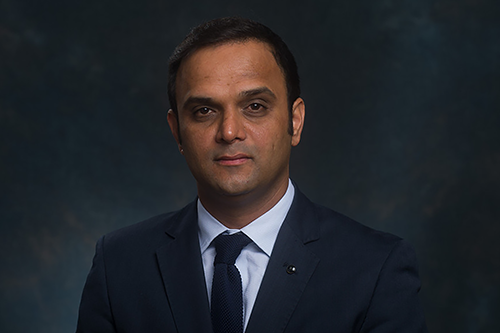
 Surya Bhatt, M.D., associate professor in the Division of Pulmonary, Allergy and Critical Care Medicine, is the latest winner of the School of Medicine’s Featured Discovery. This initiative celebrates important research from School of Medicine faculty members. Dr. Bhatt with first author Sandeep Bodduluri, Ph.D., and colleagues discovered that airway fractal dimension predicts respiratory morbidity and mortality in COPD. This knowledge, published in the Journal of Clinical Investigation, helps researchers and physicians better understand respiratory morbidity and lung function change. Read more from UAB News here.
Surya Bhatt, M.D., associate professor in the Division of Pulmonary, Allergy and Critical Care Medicine, is the latest winner of the School of Medicine’s Featured Discovery. This initiative celebrates important research from School of Medicine faculty members. Dr. Bhatt with first author Sandeep Bodduluri, Ph.D., and colleagues discovered that airway fractal dimension predicts respiratory morbidity and mortality in COPD. This knowledge, published in the Journal of Clinical Investigation, helps researchers and physicians better understand respiratory morbidity and lung function change. Read more from UAB News here.
The School of Medicine communications staff sat down with Dr. Bhatt to gain insights about his research, UAB and the science community.
Q: What compelled you to pursue this research?
The quantification of airway disease in COPD has been a challenge given the complex branching pattern and differences in size and shape of the airways. Existing metrics have mostly quantified the wall thickness or the luminal cross-sectional area of the 4th or 5th generation airways with the assumption that changes in these airways reflect changes that occur distally in the subsequent airway generations. On observing airway branching patterns during bronchoscopy, it is hard not to notice that each airway is unique. We wanted to describe a metric using high resolution CT scans that would describe a human airway with one single number to convey information about airway branching and remodeling.
Q: How do you feel your research will impact the science community?
Individuals who suffer from COPD usually have a combination of emphysema and airway disease, and phenotyping of COPD is a work in progress. Response to existing therapy is variable and phenotyping offers the promise of targeting specific therapies for individuals. Quantifying airway disease using fractal analysis and demonstrating the relationship of the airway fractal dimension with important patient outcomes in COPD takes us one step closer to accurately phenotyping airway disease in COPD.
Q: What is your research's relevance to human disease?
Our results have implications for prognostication and also for identifying individuals for targeted therapies. We found that the airway fractal dimension is suboptimal in a substantial number of patients with early and mild COPD, and this is not reflected in usual pulmonary function testing or on routine examination of CT scans. The complex branching pattern of airways is unique to each individual and is almost like a bronchial fingerprint. This is likely to have implications for smoke deposition as well as distribution of inhaled medications.
Q: How has being at UAB and living in Birmingham affected your research?
I enjoy working at UAB. The research community throughout the University, and especially within the Pulmonary Division, is very collegial. I have been able to establish multiple collaborations with investigators in the school of engineering and computer science, which have enhanced and enriched our research.
Q: What made you come to UAB?
I have always had a strong interest in clinical and translational research in COPD, which are areas that UAB has had a strong presence in. The facilities available and the support to perform cutting edge research is second to none.